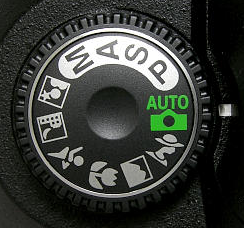Quick Guide to Understanding Digital Camera Modes

Digital Camera Modes on Nikon DSLR
One of the questions we are frequently asked during our photography courses is “What are the different digital camera modes?”
We decided to put together a short guide to help you understand the shooting modes on your digital camera.
Shooting modes are usually located on the top dial on your camera. An understanding of shooting modes is central to controlling exposure in digital photography. When you select a shooting mode you are deciding how to control exposure and how this choice may impact on how your photographs look
Automatic Modes
Automatic
Every beginner knows this one. The camera makes all the decisions for you about shutter speed, aperture, white balance, metering, ISO and focus area. Some DSLRs may let you over-ride flash so that it does not pop up when you don’t want it to. This digital camera mode is useful when you first get your camera as it lets you get used to handling it and taking your first few shots. However the camera controls how the photograph will look, which is not ideal if you wish to develop as a photographer.
Portrait Mode
This shooting mode controls depth of field to make it shallower, with shorter focal distance. This helps to blur backgrounds so that the subject is the main focal point in the photo. Less sharpening is also applied to JPGs giving a softer look to the image. Colour is less vibrant and more neutral to create natural tones. Best way to use portrait mode is to get in close, with a head a shoulders composition.
Landscape Mode
Landscape mode is the opposite of portrait, in that a large depth of field to make more of the scene in focus. Sharpening is greater too; with emphasis on edges to create a visual sense of long focal distance with everything pin sharp. Colour is more saturated with green fields looking greener and blues skies looking really blue. Vivid, punchy colour is applied in landscape digital camera modes. Flash is switched off so you might need a tripod in low light.
Macro or Close Up Mode
Macro mode is great for getting in close and enables you to photograph flowers, insects or other small objects or details which interest you. The depth of field can be very shallow if you are a Canon user, so it is often best to put your camera on a tripod to hold it static. Breathing can be enough to change the distance your camera is from the subject and render it out of focus! Nikons favour small apertures to improve depth of field in their close up digital camera modes.
Sports Mode
This is as the name suggests for subjects which are moving fast. The icon is of a running man. Sports digital camera modes increases shutter speed to freeze movement and increases ISO. Great for photographing sporting events, a day at the race-track, children or pets. Flash is switched off.
Night Portrait Mode
This mode fires flash to light your subject and the background too. Uses a slow shutter speed so you might get blurred shots if you do not use a tripod. Sometimes the blurring can be fun, so get creative and experiment with moving trails of light.
Semi-Automatic Digital Camera Modes, a stepping stone to understanding exposure
Program P (P)
This is a great mode to use to wean you away from using Auto. The camera sets shutter speed and aperture, but you can change the combinations to alter the way your photographs look. Program P also gives you access to the full menu of your camera. This means that you can change many settings. This shooting mode also looks after you, and if you try to set an aperture, shutter speed combination which would render an incorrect exposure, the camera puts on its brakes and does not let you dial in an incorrect exposure.
Aperture Priority (A/AV)
This mode lets you set the aperture you wish to take your shot in. It gives control over depth of field and focal distance. Great for landscape and portrait photography where depth of field is the priority. Take care in low light as shutter speeds can plummet. This is the post popular shooting mode for photography enthusiasts.
Shutter Speed Priority (S/TV)
Use this shooting mode for moving subjects. The camera will set the aperture to ensure that the exposure is correct. Great for either freezing action or creating slow moving trails. Take care when setting fast shutter speeds as you may capture an underexposed image if the camera goes out of the correct exposure range. You need to understand the relationship ISO plays in exposure when using shutter speed priority.
Full Manual Mode (M)
This mode is for the intermediate/advanced photographer who understands exposure. In this shooting mode you set the aperture value and the shutter speed yourself. The camera does not arrive at the correct exposure automatically when you first turn your camera on. You have to set both sides of the exposure. This is a great mode to use when light is consistent and not changing all the time, as you can take several shots on the same exposure settings. Great for indoor use too, or in the studio where light remains the same.
We hope you have enjoyed our Quick Guide to Digital Camera Modes and take the next step in your photography by understanding and contolling exposure.
Share this Post